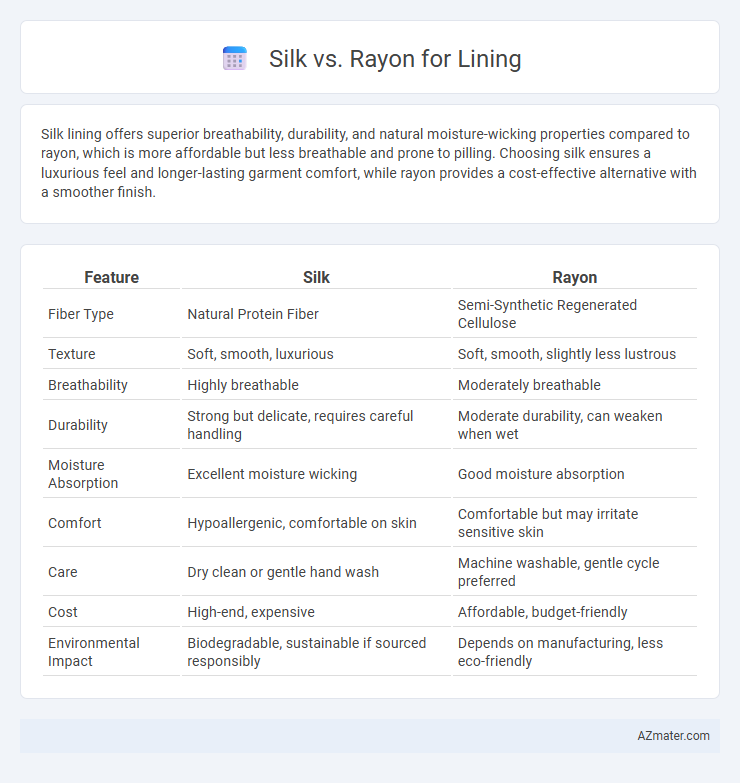Silk lining offers superior breathability, durability, and natural moisture-wicking properties compared to rayon, which is more affordable but less breathable and prone to pilling. Choosing silk ensures a luxurious feel and longer-lasting garment comfort, while rayon provides a cost-effective alternative with a smoother finish.
Table of Comparison
| Feature | Silk | Rayon |
|---|---|---|
| Fiber Type | Natural Protein Fiber | Semi-Synthetic Regenerated Cellulose |
| Texture | Soft, smooth, luxurious | Soft, smooth, slightly less lustrous |
| Breathability | Highly breathable | Moderately breathable |
| Durability | Strong but delicate, requires careful handling | Moderate durability, can weaken when wet |
| Moisture Absorption | Excellent moisture wicking | Good moisture absorption |
| Comfort | Hypoallergenic, comfortable on skin | Comfortable but may irritate sensitive skin |
| Care | Dry clean or gentle hand wash | Machine washable, gentle cycle preferred |
| Cost | High-end, expensive | Affordable, budget-friendly |
| Environmental Impact | Biodegradable, sustainable if sourced responsibly | Depends on manufacturing, less eco-friendly |
Introduction to Silk and Rayon as Lining Fabrics
Silk and rayon are popular lining fabrics known for their smooth texture and breathability, enhancing garment comfort and durability. Silk is a natural protein fiber prized for its luxurious feel, hypoallergenic properties, and moisture-wicking capabilities. Rayon, a semi-synthetic fiber made from cellulose, offers a lightweight, cost-effective alternative with a soft hand and good drape, often used to mimic the appearance of silk in linings.
Key Differences Between Silk and Rayon
Silk lining boasts natural protein fibers derived from silkworm cocoons, offering superior breathability, moisture-wicking properties, and a luxurious smooth texture compared to rayon, which is a semi-synthetic fiber made from chemically processed cellulose. Silk provides greater durability and hypoallergenic benefits, while rayon is typically more affordable but less moisture-absorbent and prone to shrinking or stretching. The environmental impact also differs, with silk being a more sustainable, biodegradable choice versus rayon's reliance on chemical-intensive manufacturing processes.
Breathability and Comfort Comparison
Silk lining offers superior breathability due to its natural protein fibers that wick moisture effectively, keeping the wearer cool and comfortable. Rayon, while smooth and soft, tends to retain moisture more, making it less breathable and potentially warmer in humid conditions. For optimal comfort in lining, silk is preferred in garments designed for temperature regulation and moisture management.
Durability and Longevity of Silk vs Rayon
Silk offers superior durability and longevity compared to rayon when used for lining, as its natural protein fibers provide resilience against wear and tear while maintaining a luxurious feel. Rayon, being a semi-synthetic fiber derived from cellulose, tends to weaken more quickly with repeated washing and exposure to moisture, leading to faster deterioration. The strength of silk fibers ensures that garments lined with silk retain their structure and appearance longer, making it a more durable and long-lasting choice for high-quality linings.
Moisture Absorption and Wicking Abilities
Silk excels in moisture absorption, naturally drawing sweat away from the skin due to its protein-based fibers, providing superior breathability and comfort for linings. Rayon, made from regenerated cellulose, also offers good moisture-wicking properties but tends to retain more moisture, leading to a heavier feel when damp. For lining applications prioritizing quick drying and moisture management, silk outperforms rayon by maintaining dryness and reducing clamminess.
Sustainability and Environmental Impact
Silk, a natural protein fiber produced by silkworms, offers biodegradability and renewable qualities, making it a sustainable choice for lining compared to rayon, which is a semi-synthetic fiber derived from wood pulp. However, silk production involves significant water consumption and energy use, while rayon manufacturing can generate toxic chemicals and cause deforestation if not sourced responsibly. Choosing sustainably harvested silk or eco-friendly rayon variants like lyocell reduces environmental impact, promoting greener textile options for linings.
Cost Analysis: Silk vs Rayon Linings
Silk linings generally cost significantly more than rayon due to the natural fiber's labor-intensive production and superior quality. Rayon offers a budget-friendly alternative, providing similar softness and drape but with lower durability and moisture resistance. For cost-conscious projects, rayon linings deliver affordability without sacrificing essential comfort and appearance.
Maintenance and Care Requirements
Silk linings require delicate care, often necessitating dry cleaning due to their sensitivity to water and detergents, which helps preserve their natural sheen and smooth texture. Rayon linings, while more affordable, demand gentle washing and air drying to prevent shrinkage and maintain fabric integrity, as they are prone to damage from high heat and rough handling. Proper maintenance of both materials extends garment lifespan but silk's luxurious feel and durability justify its higher care standards.
Best Applications for Silk and Rayon Linings
Silk linings excel in luxury garments, providing a soft, breathable, and hypoallergenic layer ideal for delicate suits, high-end dresses, and premium jackets. Rayon linings offer a cost-effective, smooth, and moisture-absorbent alternative suitable for everyday wear, casual blazers, and linings in mass-produced clothing. Choosing silk for linings enhances comfort and durability in formal or special occasion attire, while rayon suits budget-friendly, machine-washable garments with moderate breathability.
Choosing the Right Lining: Silk or Rayon?
Silk linings offer superior breathability, moisture-wicking properties, and a luxurious feel, making them ideal for high-end garments that prioritize comfort and elegance. Rayon linings provide a cost-effective alternative with smooth texture and decent breathability, suitable for more affordable or everyday clothing. Choosing between silk and rayon depends on balancing durability, budget, and the desired level of comfort in garment construction.

Infographic: Silk vs Rayon for Lining
 azmater.com
azmater.com